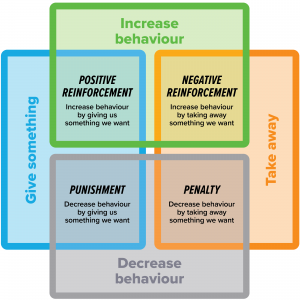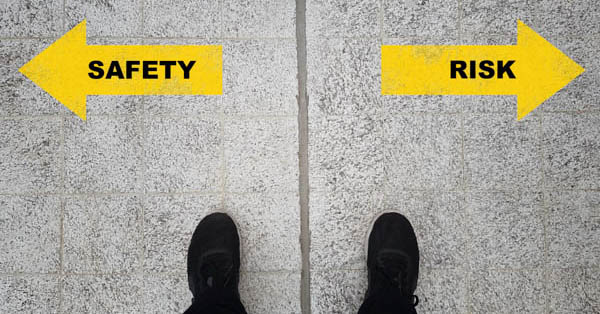Behaviour-Based Safety – Part 1 | Rewards and Penalties
by Pourya Ghani, OH&S Technical Advisor
We all know that workplace incidents can have serious human and financial costs for organizations. Most workplace injuries involve an unsafe habit or behavior. Behavioral-based safety (BBS) is a scientific attempt to understand the relationship between human nature and work, and a mechanism to improve.[1]
The aim of a BBS program is to change behavior through use of objective measures, results-based changes, and feedback with one goal in mind: to increase safety performance, reducing work-related incidents. Creating a BBS program today can help you see the benefits in your organizational culture sooner than you think.
Understanding behaviours
Before we can use BBS, we first need to understand what a behaviour is. For that, we need to recognize what happens before a behavior, and what motivates us to do certain things.
The ABC model of behaviour helps us connect the factors that lead to a behaviour (antecedents) with the resulting consequences:
- Antecedents can be factors in an employee’s external environment—such as an instruction by a supervisor on not to bend their back while lifting. Emotions and feelings, such as experiencing happiness, pain or feeling hungry, may also be antecedents to someone’s behaviour.
- Behaviours are things people choose to do. They may be observable such as being kind, respectful or not wearing PPE, also they may be internal such as feeling pain or daydreaming. Since internal behaviors can only be inferred, most behavioral interventions focus on observable and measurable behaviours.
- Consequences happen as a result of a behavior. For example, a worker may choose to report a problem, telling a supervisor, “This saw is broken,” and the consequence of that behavior could be the supervisor thanking the worker, tagging the broken saw, and replacing it with a functioning one.
Encouraging and discouraging specific behaviours
Consequences can either encourage or discourage a behaviour. If workers believe a consequence is likely and either desirable or undesirable, that belief will influence how they behave.
As a result, by giving rewards or incentives or by removing roadblocks, we can encourage behaviours that have positive consequences. Through punishment or penalties, we can discourage behaviours that have negative consequences.

Methods of encouraging and discouraging behaviours
You can use each of these four methods to teach, train, and manage behavior.[2]
For better or for worse, the collective behaviours of your people become your business culture.[3] We can begin to change behaviours (and effectively change the culture) using these methods:
- Increase a behavior by giving something (an incentive or promotion, opportunities for involvement, compliments and kudos)
- Decrease a behavior by taking away something (demotion, suspension)
Which do you choose?
Experts advise starting with positive reinforcement. Negative consequences need to be well thought out and evaluated since they can have a significant negative impact on workplace morale. But frequent incentives can lead to entitlement or misconceptions with staff—so balance is important.
How else can you influence employees’ behaviors? One way is through influencers such as:
- Self-Explanation. Sharing personal experience, or rationale behind workplace polities, addressing attitudes and risk tolerance.
- Engaging supervisors and coworkers, leaders, and teams to address the risks and consequences
- Reminding employees of past (positive or negative) consequences.
- Using toolbox talks, signs, checklists, and accountability tools to reinforce positive behaviours and discouraged negative behaviours and habits.
In most situations self-explanation trumps all other influencers, and it’s a method employers can use effectively. By providing solutions, directions, and explanations with the aim of standardization, employers can encourage the right behavior in most workplace situations.
Managing behaviour by reinforcing safety culture
If employers fail to provide answers or respond to questions, lower staff participation and false assumptions can lead to unsafe habits and attitudes and poor organizational culture.
According to Ostrom (1993), in good safety cultures, employees are alert for unexpected changes and ask for help when they encounter any unfamiliar hazard. Companies with strong safety cultures reward people who point out safety problems and who are innovative in finding ways to locate and assess workplace hazards.[4]
Since it is difficult to manage every behaviour at work, employers must rely on safety culture to help create norms. Management commitment is the driving force of a safety culture. This commitment is then translated into policy, practices, rewards, and penalties that work together to build safety culture into your organizational culture.
Six management practices are key in building a healthy safety culture:
- Rewards
- Training
- Hiring
- Communication/feedback
- Participation
- management support [5]
If we consider culture as a series of behaviours with consequences, then by aligning people with specific safe behaviours, we can build a strong safety culture. To do this, though, requires management commitment and buy-in at all levels of the organization. That buy-in comes from a clear and consistent explanation of why we do what we do, how we do it, and why.
Watch for more on this topic
- Part Two: Habits
- Part Three: A Behaviour-based Safety (BBS) Program
- Part Four: A Safety Culture with BBS in mind
More theory and background
BBS concepts grew out of behavioral learning principles conceived by behaviorists during the late 19th century and developed into an approach through integrating organizational development with quality and safety management (Parand and Foster, 2006).[6]
The ABC model of behaviour (Antecedent, Behaviour and Consequences) was created by Dr. Albert Ellis, an American psychologist and psychotherapist researcher in human behavior from Columbia University.
B.F Skinner’s: Operant Conditioning helps explain why studying a behavior’s cause and its consequences is the best way to understand and regulate it.[7] Based on Thorndike’s “law of effect” which stated that a behavior that is followed by pleasant or desirable consequences is likely to be repeated, while behavior that is followed by undesirable consequences is less likely to be repeated (McLeod, 2018), Skinner’s model outlines four methods of conditioning:
- Positive reinforcement: a desirable stimulus is introduced to encourage certain behavior.
- Positive punishment: an undesirable stimulus is introduced to discourage the behavior.
- Negative reinforcement: an undesirable stimulus is removed to encourage the behavior.
- Negative punishment (also called extinction): a desirable stimulus is removed to discourage the behavior.[8]
Each of these four methods of conditioning can be implemented to teach, train, and manage behavior.[9]
As suggested by Lingard (2002) and Steward (2002, P. 11), the basic principle of the behavioral approach acknowledges that change in behaviors will only occur if the new behaviors lead to a higher probability of receiving desired consequences (Schneider, 1990).[10]
[1]https://ro.uow.edu.au/cgi/viewcontent.cgi?referer=https://scholar.google.ca/&httpsredir=1&article=1199&context=smhpapers Abstract page 4, 3rd paragraph.
[2] https://positivepsychology.com/positive-reinforcement-psychology/
[3] https://www.merriam-webster.com/dictionary/culture
[4] Pertanika J. Soc. Sci. & Hum. 21 (4): 1327 – 1339 (2013)
[5] Pertanika J. Soc. Sci. & Hum. 21 (4): 1327 – 1339 (2013)
[6] Page 684 NOVEMBER 2008 VOLUME 108 NON-REFEREED PAPER The Journal of The Southern African Institute of Mining and Metallurgy
[7] https://positivepsychology.com/positive-reinforcement-psychology/
[8] https://positivepsychology.com/positive-reinforcement-psychology/
[9] https://positivepsychology.com/positive-reinforcement-psychology/
[10] Pertanika J. Soc. Sci. & Hum. 21 (4): 1327 – 1339 (2013)



